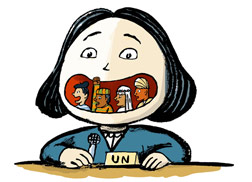How does interpretation work at the United Nations?
Libyan leader Muammar Qaddafi delivered a rambling address to the United Nations in New York City on Wednesday morning, calling Barack Obama "our son" and railing against the U.N. Security Council. He spoke not in Arabic, Libya's official language, but a local Libyan dialect. Does the United Nations have an interpreter for every dialect in the world?
No. Speakers at the United Nations are supposed to deliver their speeches in one of the organization's six official languages: English, French, Spanish, Russian, Arabic, and Chinese. U.N. interpreters then translate the lecture into the other five languages. If the speaker doesn't use an official language—either as a political statement or because he doesn't know one—the speaker has to bring along his own interpreter. That interpreter then translates into one of the official languages—usually English or French—and the other interpreters translate from that interpretation. (Qaddafi brought his own interpreter.) Alternatively, the speaker can provide a written translation of his speech in one of the official languages, as long as he doesn't deviate from the text in his remarks.
The United Nations uses simultaneous interpretation, which means translating on the fly without breaks (as opposed to consecutive interpretation, in which the speaker and translator alternate). At any given moment, the U.N. Interpretation Service has a dozen interpreters working six booths—one for every official language. The pair of interpreters in the English booth translates into English, the French booth translates into French, and so on. Attendees can then listen to the interpretations on headphones, clicking across channels for different languages. The job is exhausting, so interpreters will usually switch off every 20 minutes or so. They can also take breaks when the speech is in their language, since no translation is necessary.
U.N. interpreters don't need to know every official language. Rather, the U.N. hires interpreters who can translate into their native language from at least two other languages. A Russian interpreter, for example, might also know English and French. But he might not know Chinese. In that case, if the speaker is Chinese, the interpreters will use what's called a "relay system." The interpreters in the Chinese booth will translate the original speech into English or French, and the rest of the interpreters will translate that version into their own languages. Under the relay system, the final interpretation is thus translated twice from the original speech. This method does lead to inaccuracies, which is why someone must review the interpretations afterward and correct them for the official record. It's also why the United Nations allows only one intermediary language in the relay system—any more and there's too much room for error.
The United Nations hires about 120 interpreters—not to be confused with translators, who translate text—who are considered the best in their profession. No education is required, but roughly 70 percent of the members of the American Translators Association have college degrees. Interpreters slot the languages they know into three categories: A, B, and C. Your so-called "A language" is your native language, which you speak perfectly. A "B language" is one that you've mastered—from living in the native country, say—but which you can't speak with total fluency. A "C language" is one you merely know well, perhaps from studying or travel. Interpreters can translate into and from all of their languages with varying levels of proficiency. But the United Nations will hire interpreters only to translate into their A language, and then only at the highest level.
Got a question about today's news? Ask the Explainer.
Explainer thanks Hossam Fahr of the U.N. Interpretation Service, Steven Mines of the Austin Area Translators and Interpreters Association, and Jiri Stejskal of the American Translators Association.



Comentários